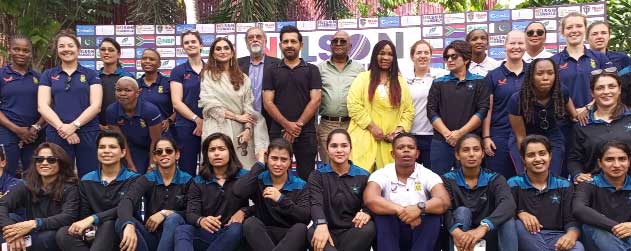At present, mankind is in an era of major development as well as profound transformation and change. The trend toward multi-polarity and economic globalization is surging. IT applications in social development and cultural diversity are making continued progress. A new round of scientific and industrial revolution is in the making Interconnection and interdependence between countries are crucial for human survival so, outweigh factors causing war, and the trend of Investment, development, cooperation, and win-win outcomes has gained stronger momentum.
Our Earth is a blue planet, where the ocean covers 70% of the Earth’s surface and connects all humanity. Mankind obtains resources from the ocean, exchanges commodities, and spreads culture through navigation. The blue planet inhabited by humans is not divided into individual islands but connected by the ocean as a maritime community with a shared future so, in the context of global megatrends, such as direction of Investment, population growth, climate change, concerns for food security, and energy demand, our relationship with the ocean has become more close and complex.
Besides this marine ecosystems confront various issues ranging from community-level concerns to broad environmental and economic issues such as overfishing, coastal hypoxia, and ocean acidification so, investments are needed to catalyze blue growth in the form of new public and private financing. Such investments could deliver net socioeconomic benefits exceeding US$1 trillion per year. As the world is confronting the challenges of sustainable economic development these days along with the challenges of sovereignty and security, sustaining national development, access to food and energy, management of natural resources, effects of climate change, and resilience in the face of natural disasters. With a growing population, set to rise over nine billion by 2050, these pressures and impacts are likely to intensify unless the world becomes more intelligent about managing these essential resources.
Countries are moving towards seas and oceans to sustain their economic development and national power and the phenomenon is known as “Blue Economy”. The idea of Blue Economy recognizes the “seas and oceans” as main drivers for the economic development with great potential for innovation and growth. But the main question is that, how Blue waters can help Pakistan to speed up economic growth? What are the challenges we are facing to develop as a maritime nation? What are the opportunities available? And, how can these opportunities work for us? The trend of “Getting Blue” might be new for the developing states but history reveals that all “Great Powers” are maritime nations.
Concept of Blue economy is emerged as a parallel economy along with the traditional economies these days but the blue growth accompanied with the increasing and cumulative challenges related to integrated solutions and finance approaches. It requires the broader sustainable finance landscape to develop a sustainable blue economy. Innovative finance is based on the premise that traditional funding from taxpayers of public goods and delivery entirely through public services alongside purely commercial finance for private business are on their own insufficient to deliver the required transition at the necessary scale speed and level of technology.
Pursuing the blue economy requires access to affordable long-term financing at scale, yet small states have thus far experienced limited success in catalyzing public and private investments in the blue economy at scale. Immediate financial constraints, common to most small states, include a lack of fiscal space, and stagnant or declining flows of both official development assistance and foreign direct investment. Developing nations mostly suffer from large, unsustainable levels of external debt along with the challenges of developing the enabling conditions for the blue economy, including the institutional, regulatory, governance, legislative, and human resources needed to achieve both inter-sectorial and transboundary coordination; the high upfront research, development, and capital costs; and insufficiently developed ocean industry technologies.
Developing nations have had encouraging success in attracting blue financing to support sectorial and inter-sectorial planning and policy coordination, and have also attracted blue investments in sustainable fisheries development and protection, aquaculture, water and waste treatment, and addressing marine ecosystem degradation. Most financing to date has been provided by international public finance sources, including through grants and loans from global and regional development banks, other development finance institutions, and both bilateral and multilateral donors.
Significant sources include the Global Environment Facility (GEF), the United Nations Development Program (UNDP), the World Bank Group, the United Nations Environment Program (UNEP) and the United Nations Food and Agriculture Organization (FAO) while some countries are benefiting both through direct country support and through multilateral programs supporting regional institutions of which they are members but the internal support available is not enough until and unless it is supported by local banking sector as we all know that, Pakistan’s blue growth is highly linked with the CPEC so huge capacity building is necessary to support the growth because Banking Sector plays a crucial role in economic growth and development performance in any economy.
In any plan of economic development, capital occupies a position of strategic importance. Allocation of Capital is one of the major functions of the banking sector. The banking sector attracts savers to save and funds enterprises to operate and achieve their goals. Without the banking sector, borrowers would have difficulty finding lenders i.e. savers. No economic development of sizable magnitude is possible unless there is an adequate degree of capital formation. A very important characteristic of an underdeveloped economy is a deficiency of capital which is the result of insufficient savings made by the community. Backward economies hardly save 5% of the national income, whereas they should save and invest at least 15%.
Banks perform strong role in removing the deficiency of capital by preparation of stores by offering appealing rates of plotting, subsequently changing over reserve funds, which generally would have stayed inactive into dynamic capital, by dispersing the reserve funds through advances among undertakings which are associated with monetary improvement. Along these lines, they advance the improvement of farming industry, exchange, and industry but in countries like Pakistan where saving habits are not fully developed we are struggling to build innovative financial capacity that will not only rejuvenate our blue growth but will act as a catalyst to bring sustainable development in our country.
Key Policy Actions Required:
While many small countries are making modest progress in attracting finance and investment for the blue economy, capitalizing on the transformative potential of the blue economy will need financing and investment at scale, across a much wider range of countries and regions and in many of the emerging and new blue economy industries that offer the potential to transform small states’ long-term growth prospects. Several key policy actions can help develop this approach.
1st, National and Regional initiatives to develop an enabling framework for the blue economy should be strengthened. Greater, more reliable flows of long-term financing can only emerge in the presence of an enabling framework for the blue economy. Developing nations need to redouble their efforts to mainstream the blue economy in national and regional development plans; and to establish an effective enabling framework for the blue economy, including governance, institutional and policy frameworks that reflect the transboundary and integrated land, coastal and ocean characteristics of the blue economy. Practical initial steps include strengthened coordination and cooperation across sectors and ministries, developing new national and regional capacities in activities and skills supportive of the blue economy, for example, in marine spatial planning, oceanographic mapping, ocean conservation and marine protection, and in integrated cross-sectorial planning. Small states, supported by development partners, can develop new information-sharing portals and intra- and inter-regional databases on blue investment project financing.
2nd, domestic resource mobilization for the blue economy should be strengthened. Sustaining the transformation to a blue economy will necessitate much stronger reliance on domestic financing, requiring developing countries like Pakistan to progressively convert public expenditure from land-based to integrated land based, coastal and ocean-based investments. While this process has commenced, in particular through the development of MPAs, more substantive initiatives are needed to develop new revenue streams that can be reinvested in further blue economy investments.
3rd, sharing knowledge and absorbing regional and other tools and lessons of good practice are key. Sharing knowledge on the blue economy, through lessons learned and evidence of success, assists countries and regions to make the short-term investments needed to transition to a blue economy in the longer term (UNEP 2015). Among many examples that can be of use to developing nations is the ISLANDS program of the Indian Ocean Commission, which links spatial development planning with integrated policy frameworks for the blue economy to help policymakers understand policy choices and trade-offs in developing strategies for the national and regional blue economy, and the United Nations Economic Commission for Africa, which has developed a practical seven-step guide for African countries to mainstream the blue economy into national policies, laws, regulations, and practices.
4th, a new approach led by small countries and supported by international development partners, is needed to capture and share information on the sources, instruments, and uses of blue financing in and for small states. Initiatives to capture information on financing the green economy like, the Climate Bonds Initiative that can emulate and develop the blue economy, and initiatives such as SIDS Dock, which shares information on renewable energy initiatives in SIDS, can be broadened, to include a wider range of sectors, including blue financing for aquaculture, marine biotechnology, and DSM, providing information on sources, terms, and recipients of blue finance.
5th, partnerships between developing countries should be expanded and new sources of blue finance should be explored. Deepening existing partnerships and exploring new initiatives may be pivotal to future resource mobilization. Partnerships to date have been effective in honing developing countries’ policy positions, mobilizing international acknowledgment of small countries’ unique vulnerabilities and fashioning global goals relevant success, assisting countries and regions to make the short-term investments needed to transition to a blue economy in the longer term.
6th, Establish a network of researchers, industry stakeholders, government personnel, and media outlets to generate and disseminate awareness and knowledge regarding the scope and potential of blue resources. Information campaigns and mainstreaming and dissemination of the knowledge created by researchers for broader awareness and insights into the field will be beneficial.
7th, A complete survey and manpower audit of the Mercantile Marine Department (MMD) is required to identify the shortcomings, capacity, and needed up-gradation to fulfil its functions.
8th, Conduct a dedicated and full-fledged survey of Pakistan’s maritime zones to ascertain the nature, type, and extent of resources to better understand Pakistan’s blue potential.
9th, Strategize for a conducive environment for foreign and local investors to channel investments into the maritime sectors.
10th, Review procedural inefficiencies and introduce reforms for fostering investor confidence and improving prospects of business in the blue economy.
11th, Putting in place consistent long-term policies that are dynamic rather than static.
12th, Formulate an exclusive National Blue Growth Policy with clearly defined goals and realistically set targets to be achieved within a reasonable time. Greater coordination and consultations among academia, government, and other stakeholders are the key to achieving consensus in decision-making.
13th, Eliminate subsidies for bringing in competitiveness.
14th, Invest in R&D and forge partnerships with international research groups to keep pace with the current international practices.
15th, Transformative change requires political support and civil society engagement to gain momentum. The strategic planning frameworks created under the GEF-supported Large Marine Ecosystem and Regional Seas Programs provide readily available policy frameworks to obtain the needed political support and momentum. This will be needed for the transparency and accountability required for establishment of new blue economy Asset classes. It can also facilitate monitoring of the long-term sustainability of economic, social, and environmental impact.
16th, Bridges need to be built between the activities of the development community and those of the commercial investment community. Both parties can learn from each other and jointly work on pipelines of investible projects from the conceptual phase through to deal close. Public funding will be needed to de-risk financing of the first sets of pipeline projects, helping to bring these new asset classes to the market.
17th, Development of more pre-feasibility studies of viable investment cases are needed. There’s a clear need and interest from both the investor community and by local stakeholders for pre-investment assistance. It is important that this is done well in the initial stages so blue economy investments build a strong track record of success.
Despite the odds, developing nations are making steady progress in securing blue financing and investment; however, this progress is piecemeal and too slow and insufficient to convert the transformative potential of the blue economy into reality. Increased policy efforts by developing nations and strengthened support from international development partners can help accelerate blue finance. In some new ocean industries, technological and other constraints are likely to limit the ability to attract financing at scale for the foreseeable future.
Transformative approach of innovative financing for’getting blue’




